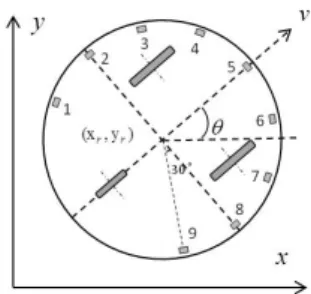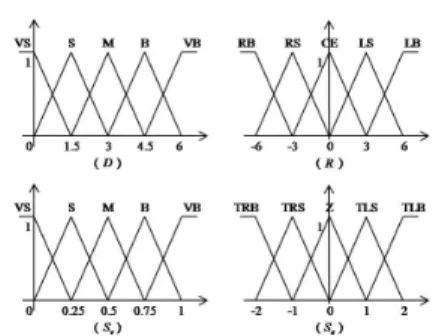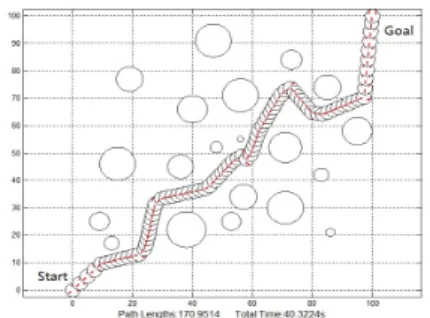Autonomous Navigation of a Mobile Robot in Unknown Environment Based on Fuzzy Inference
Ran Zhao
1, Dong-Hwan Lee
1, Hong-Kyu Lee
1*1Department of Electrical Engineering, Korea University of Technology and Education
미지 환경에서 이동로봇의 퍼지추론 기반 자율항법
조 연1, 이동환1, 이홍규1*
1한국기술교육대학교 전기공학과
Abstract This paper presents a navigation problem for an autonomous mobile robot in an unknown environment.
The environment contains various types of obstacles and is completely unknown to the robot. Therefore, all of the surrounding information must be detected by the robot's proximity sensors. A navigation method was developed based on a fuzzy inference system to guide the robot to move along a collision-free path and reach the goal position quickly.
The obstacles are assumed to be static, and both regular and irregular types of obstacles were investigated. A wall following method is also proposed for a special environment that contains a labyrinth or sharp U-valley obstacles.
Simulation results demonstrate that the proposed method has great potential for this navigation problem.
요 약 본 논문은 다양한 형태의 방해물에 대한 정보를 알 수 없는 미지의 환경에서 자율이동 로봇의 항법에 관한 제안을 하고 있다. 로봇의 이동에 따른 주변의 정보는 로봇에 부착되어 있는 근접센서를 통하여 감지하고, 충돌을 피하고 목적지에 가능한 한 빨리 도착할 수 있는 경로로 유도하기 위하여 퍼지추론에 기반 한 항해방법을 개발하였다. 여기에서 방해물들은 정지되어 있고 정형화된 경우와 비정형화된 형태들이 고려되었으며 미로와 U형태의 계곡으로 구성된 예리한 방해물들을 특별히 포함하고 있다. 벽을 따라 이동하는 방법 또한 제안하고 있으며 모의실험을 통하여 제안하고 있는 방법이 이동로봇의 항법문제를 해결하는 효과적인 방법이 된다는 것을 증명하였다.
Keywords : fuzzy inference, robot navigation, path planning, wall following, mobile robot
*Corresponding Author : Hong-Kyu Lee (Korea University of Technology and Education) Tel: +82-41-560-1162 email: hongkyu@koreatech.ac.kr
Received November 24, 2015 Accepted March 3, 2016
Revised March 2, 2016 Published March 31, 2016
1. Introduction
Autonomous navigation of a mobile robot is a popular issue in robot field. Mobile robots have been used extensively in various fields such as space research, factory automation and defense security, which economized the labor force to be engaged in other aspects. In these applications, finding a safety path for the robots is a prerequisite for success. The navigation problem of autonomous mobile robot
(AMR) includes several difficult phases that need to be overcome, such as obstacle avoidance, position identification, driving safety, etc. That is, a reliable path planning algorithm must be able to identify the current location of the robot, avoid any collisions, and determine a suitable path to the goal.
Generally speaking, the navigation problem together with its path planning usually can be done by two ways, that is, the global path planning and local path planning. In the past few decades, several methods
have been suggested to solve this problem for AMRs.
Such as neural network [1], genetic algorithm [2], artificial vision method [3] and PID control [4] in static environment. The methods above are usually used in global path planning and hardly be used in real-time control. Many other real-time control methods applied in static environment have also been developed. Such as in [5], a navigation method combined with the inertial sensors based on an improved remote control algorithm for mobile robots was proposed. Researchers in [6] developed an expanded guide circle method for the navigation problem of mobile robots and improved the efficiency of the remote operation. There are many traditional methods designed for global path planning have also been extended to local path planning, such as potential field method [7], road map method [8] and rolling window method [9], etc. The fuzzy logic controller for the navigation and obstacle avoidance problem of mobile robots has also been studied by researchers for years [10, 11]. But most of above researches need a global perspective, such as central server, global image or part of environment information. Therefore, come studying the proposed problem in completely unknown environment more seem to be have the necessity. In this work, we focus on a fuzzy-based navigation approach for a autonomous mobile robot in completely unknown environment. By using a set of proximity sensors the robot can avoid both regular and irregular shape of obstacles. In the special environment which contains labyrinth or U-valley sharp obstacles, a wall following method was proposed.
2. Problem Formulation
The experimentations in this work are mainly simulated with a classic wheeled mobile robot. This kind of robot has two DC motors for left and right wheel and both side has an encoder, so that the robot can detect how far each motor has moved by itself. As
shown in Fig. 1, this robot has 9 proximity (ultrasonic) sensors. These sensors are divided into three groups and have been installed at the front, left side and right side of the robot. These sensors are assembled by every 30 degrees and are used to detect the distance to the surrounding obstacles.
In order to simply the simulation, the robot will be considered as a unicycle. Thus, the kinematic functions can be described as the following equations:
×
×
, (1)
where
is the coordinates of robot’s center point. and are the linear and angular velocities of the robot respectively. is the angle between the robot’s moving direction and x-axis.Fig. 1. Structure of a wheel mobile robot
3. Fuzzy Logic Controller
Fuzzy variables are processed using a system, called a fuzzy logic controller (FLC). It involves three processes: fuzzification, fuzzy inference and defuzzification.
The fuzzification process converts a non-fuzzy input value to a fuzzy value. As an example, the input variables of FLC in this paper can be described as:
VS S M B VB
VS S M B VB
RB RS CE LS LB
VS TRB TRB TLB TLB TLB
S TRB TRB TLB TLB TLB
M TRS TRS Z TLS TLS
B TRS Z Z Z TLS
VB TRS Z Z Z TLS
, (2)
(3)
where is the distance between the forward obstacles and the robot body, and is the distance difference between the front-left and front-right obstacles. We use to denote the distance detected by the
sensor. The rest sensors , , and are applied in the wall following process and used to insure the safety distance when the robot turns left or right.
Denote that the maximum linear velocity is , and the maximum angle of the robot rotates for one time is . and are the scale of and respectively, which will be the output variables of FLC. The fuzzification process of a FLC transforms a non-fuzzy input values to a fuzzy value. For fuzzifier, the input and output variables can be divided into several linguistic terms as follow:
VS: very small; S: small; M: medium; B: big;
VB: very big; RB: right big; RS: right small;
CE: center equal; LS: left small; LB: left big;
TRB: turn right big; TRS: turn right small;
TLS: turn left small; TLB: turn left big; Z: zero.
The conversion of no-fuzzy input values to fuzzy values is performed by using the membership functions which provide fuzzy terms with a definite meaning. In this paper, the triangular membership functions were used. As shown in Fig. 2, define that when the distance between the robot body and the front-left obstacles is bigger (smaller) than the distance between the robot and the front-right ones, the value of is positive (negative). When the robot turns left, the output variable is positive, otherwise, it is negative.
The process of fuzzy inference usually uses a set of rules to appoint the desired control behavior. A rule is a condition description taking the form of “If…The n…” rules. The rules set used in this paper are as shown in Table 1. Specially, when the value of
distance difference is zero, the robot is fixedly set to turn left.
Fig. 2. Membership functions of input and output variables Table 1. Rules set of FLC
4. Navigation Process
Our purpose is to guide the robot to move in the multi-obstacle environment without collision and reach the target position. Firstly, the robot will rotate towards the target and move ahead with a fixed speed. Once the sensors detect any obstacle block the way, the fuzzy inference algorithm is to be activated.
Before the robot moves ahead, in order to ensure safety, firstly the robot will check whether the distance between the robot and obstacles is far enough than the safety distance. As shown in Fig. 3, the robot has moved from the position to the current position
. The robot is too close to the obstacle now. Instead of moving ahead immediately, the robot will rotate with a certain small angle toward the side and detect the distance again. If the distance now is also small than the safety distance, the robot will keep on
rotating with the angle again and again until achieve a safe direction. Assume that after times of rotation, the robot got a safe direction and moved to the next position . In this process, the rotation angle should be:
× . (4)
In the special condition with big obstacles (or a wall) or a U-valley obstacle, the robot might be guided further and further from the goal position or moves back and forth inside the U-valley obstacle. Thus, if the robot can move along the edge of the obstacle until leave this area, it will be able to escape this problem successfully. As shown in Fig. 4, a wall following method named angle compensation method was developed here.
Fig. 3. Process of exploring the way forward
Fig. 4. Wall following method
In Fig. 4, we assume that the robot has moved from position to the current position . The robot now is on the left side of the obstacle and the current direction is denoted by the dotted arrow . and
are the distance between the robot to the obstacle which detected by the and sensor respectively.
Thus, if the robot can rotate right with the angle , the moving direction will parallel to the edge of the
obstacle. Through the geometry knowledge, this angle can be easily described as:
××∘∘
∘, (5)where is the radius of the robot.
5. Simulation Results
In order to verify the effectiveness of the proposed algorithm, a series of experiments have been simulated with Matlab. The multi-obstacle environment was set as × unit-length and the start and goal positions are and respectively. The accelerated speed won’t be considered, and the radius and the maximum speed of the robot are set as 2.5 unit-length and 6 unit-length per second. The position of the robot will be recorded by every 0.5 second.
Both the regular (circle shape) and irregular (geometrical shape) obstacles have been simulated in this paper.
The results in the environment with regular obstacles are as shown in Fig. 5. In this case, the obstacles are expressed as various kinds of circles which have different radius. In this figure we can see that once the sensors detected any obstacle block the way of robot, then the fuzzy logic controller was started to guide the robot to find a collision-free path with a low speed. After being guided far away from the obstacles, the robot was driven towards the goal position with a higher speed.
The simulation result with irregular obstacles was shown in Fig. 6. In this figure, the simulation with several irregular obstacles composed by different kinds of geometrical shapes was performed. Form this result we can see that when the edge of the obstacles was straight (like a wall) the wall following method was activated, and then, the robot was guided to move along the edge for avoiding the obstacles.
Fig. 5. Result with 20 circle shape obstacles
In order to verify the proposed wall following method, the special environments with labyrinth and U-valley sharp obstacles were also simulated as shown in Fig. 7 and Fig. 8(b) respectively. In these special conditions, the robot can also achieve the goal positions by driving along the inner edges.
Comparatively, the result of simulation without any wall following method in the environment with the U-valley shape obstacle are as shown in Fig. 8(a). By using the traditional fuzzy inference method only, the robot was always guided to move back and forth inside the obstacle until the end of pre-set maximum permissible time.
Fig. 6. Result with geometrical shape obstacles
Fig. 7. Result with labyrinth shape obstacle
Fig. 8. Simulation of U-valley obstacle without (a) and with (b) wall following method
6. Conclusions
This paper studied a navigation problem for autonomous mobile robot in unknown environment using fuzzy inference system. The environment information and the position of obstacles were detected all by robot’s sensors. In this work, both regular and irregular types of obstacles were investigated. The simulation provided satisfactory results for the proposed problem and the fuzzy approach and the wall following method have been verified to be effective.
In the real applications of the future work, the uncertainties caused by the accuracies of sensors should be considered in the application of the proposed wall following method. The performance of a fuzzy inference is influenced by its knowledge base (rule).
Thus, it is essential to adjust the rules of fuzzy controller to get a better performance, which will be the next work for us. The adjust method can be viewed as an optimization process, so a neural network or a genetic algorithm offers a possibility to solve this problem.
References
[1] D. Janglová, “Neural Networks in Mobile Robot Motion,” International Journal of Advanced Robotic Systems, Vol. 1, No. 1, pp. 15-22, 2004.
DOI: http://dx.doi.org/10.5772/5615
[2] C. C. Hsu, Y. C. Liu, “Path planning for robot navigation based on Cooperative Genetic Optimization,”
Networking, Sensing and Control (ICNSC), 2014 IEEE
11th International Conference on, IEEE, pp. 316-321, April 2014.
DOI: http://dx.doi.org/10.1109/icnsc.2014.6819645 [3] R. Carelli, C.M. Soria and B. Morales, “Vision-based
Tracking Control for Mobile Robots,” in Proceedings of 12th International Conference on Advanced Robotics, pp. 148-152, July 2005.
DOI: http://dx.doi.org/10.1109/icar.2005.1507405 [4] P. K. Padhy, T. Sasaki, S. Nakamura and H. Hashimoto,
“Modeling and Position Control of Mobile Robot,” in Proceedings of 11th IEEE international Workshop on Advanced Motion Control, pp. 100-105, Mar. 2010.
DOI: http://dx.doi.org/10.1109/amc.2010.5464018 [5] D. Q. Khanh, Y. S. Suh, “Mobile Robot Destination
Generation by Tracking a Remote Controller Using a Vision-aided Inertial Navigation Algorithm,” Journal of Electrical Engineering & Technology, Vol.8 No.3, pp.
613-620, May, 2013.
DOI: http://dx.doi.org/10.5370/JEET.2013.8.3.613 [6] S. H. Park, G. W. Kim, “Expanded Guide Circle-based
Obstacle Avoidance for the Remotely Operated Mobile Robot,” Journal of Electrical Engineering & Technology, Vol.9 No.3, pp. 1034-1042, Sep, 2014.
DOI: http://dx.doi.org/10.5370/JEET.2014.9.3.1034 [7] S. S. Ge, Y. J. Cui, “Dynamic motion planning for
mobile robots using potential field method,”
Autonomous Robots, Vol. 13, No. 3, pp. 207-222, 2002.
DOI: http://dx.doi.org/10.1023/A:1020564024509 [8] Van Den Berg J. P., Overmars, M. H., “Roadmap-based
motion planning in dynamic environments,” Robotics, IEEE Transactions on, Vol. 21, No. 5, pp. 885-897, 2005.
DOI: http://dx.doi.org/10.1109/TRO.2005.851378 [9] C. G. Zhang, Y. G. Xi, “Rolling path planning and
safety analysis of mobile robot in dynamic uncertain environment,” Control Theory & Applications, Vol. 20, No. 1, pp. 37-44, 2003.
[10] M. Wang, James N.K. Liu, “Fuzzy Logic Based Robot Path Planning in Unknown Environment,” in Proceedings of 4th International Conference on Machine Learning and Cybernetics, vol.2, pp. 813-818, Guangzhou, China, Aug. 2005.
[11] K. H. Su, T. P. Phan, “Robot path planning and smoothing based on fuzzy inference,” System Science and Engineering (ICSSE), 2014 IEEE International Conference on. IEEE, pp. 64-68, July, 2014.
Ran Zhao [Regular member]
•Jul. 2006 : ShanDong Univ., Dept.
of Information and Computation Science, BS
•Aug. 2009 : Korea Univ. of Technology and Education, Dept.
of Electrical Eng., MS
•Feb. 2012 : Korea Univ. of Technology and Education, Dept.
of Electrical Eng., PhD Candidate
<Research Interests>
Mobile Robot, Fuzzy Logic Control, Genetic Algorithm
Dong-Hwan Lee [Regular member]
•Feb. 1999 : Korea Univ. of Technology and Education, Dept.
of Electrical Eng., BS
•Feb. 2006 : Korea Univ. of Technology and Education, Dept.
of Electrical Eng., MS
•Feb. 2010 : Korea Univ. of Technology and Education, Dept.
of Electrical Eng., PhD Candidate
•Mar. 2006 ~ Current : Korea Polytechnic Colleges, Dept.
of Smart Grid Electric, Electronic and Control, Professor
<Research Interests>
Control Theory, PLC Control, Genetic Algorithms
Hong-Kyu Lee [Regular member]
•Feb. 1977 : Seoul National Univ., Dept. of Electronics Eng. BS
•Feb. 1979 : Seoul National Univ., Dept. of Electronics Eng. MS
•Aug. 1989 : Seoul National Univ., Dept. of Electronics Eng. PhD
•Mar. 1979 ~ Feb. 1992 : Agency for Defence Development, Senior Researcher
•Mar. 1992 ~ Current : Korea University of Technology and Education, School of Electrical, Electronics and Communication Eng., Professor
<Research Interests>
Genetic Algorithm, Moving Robot, Network Optimization


